University of Maryland: Interstate Hotels and Resorts Situation Audit
VerifiedAdded on 2023/01/23
|11
|2687
|68
Report
AI Summary
This report presents a comprehensive situation audit of Interstate Hotels and Resorts, a leading global hotel management company. The audit covers various aspects, including the company's mission, vision, values, and goals, organizational strategies and objectives, strategy types, and competitive advantages. It delves into the organizational size and structure, critical resources such as human resources, technology, physical, and financial aspects. The report also examines leadership, governance, and management, along with the company's strengths, weaknesses, and approach to learning and change. The analysis provides a detailed overview of the company's performance, competitive positioning, and operational strategies, culminating in conclusions and recommendations for future growth and improvement, supported by relevant references. The report fulfills the requirements of an MBA 610 assignment at the University of Maryland University College.
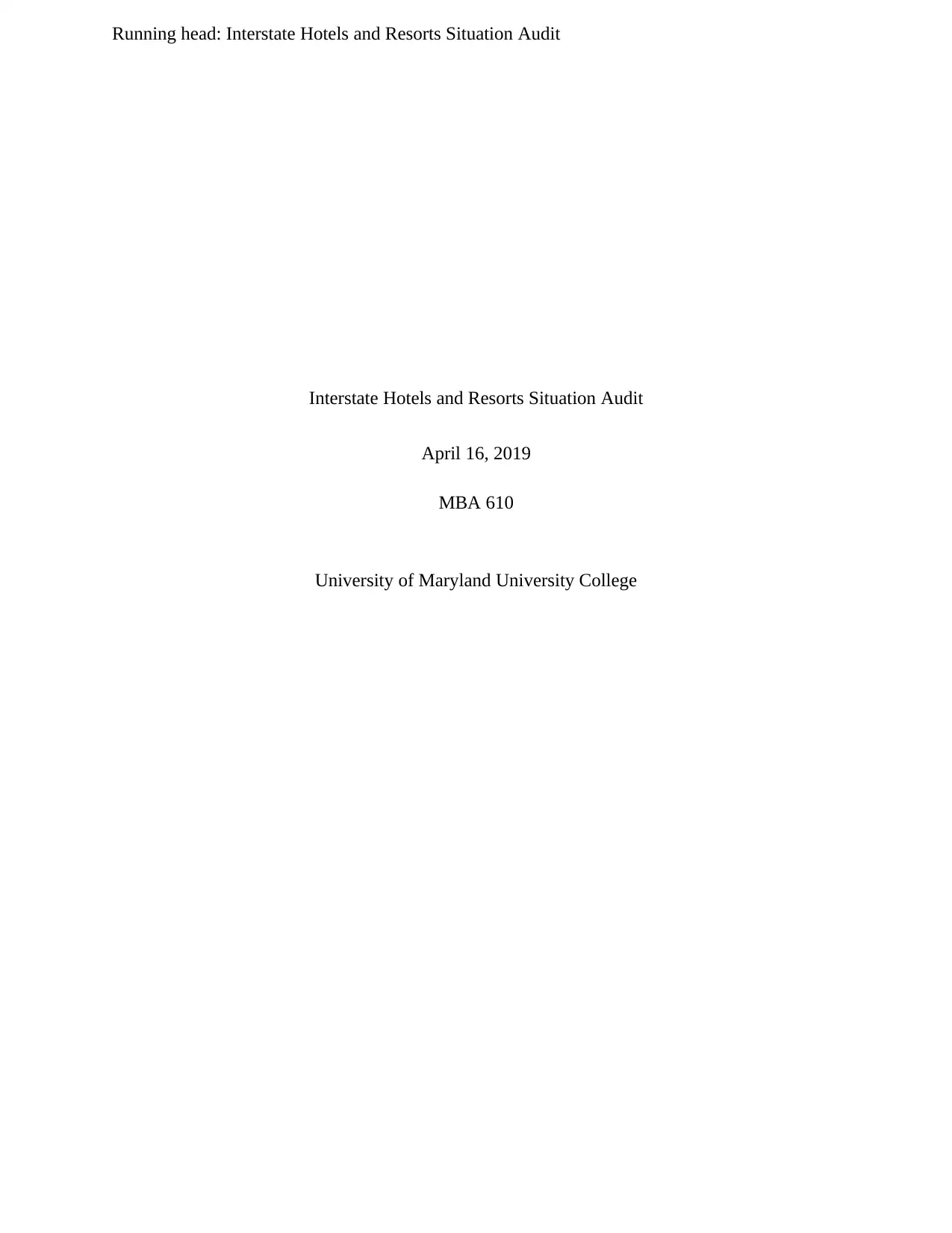
Running head: Interstate Hotels and Resorts Situation Audit
Interstate Hotels and Resorts Situation Audit
April 16, 2019
MBA 610
University of Maryland University College
Interstate Hotels and Resorts Situation Audit
April 16, 2019
MBA 610
University of Maryland University College
Paraphrase This Document
Need a fresh take? Get an instant paraphrase of this document with our AI Paraphraser
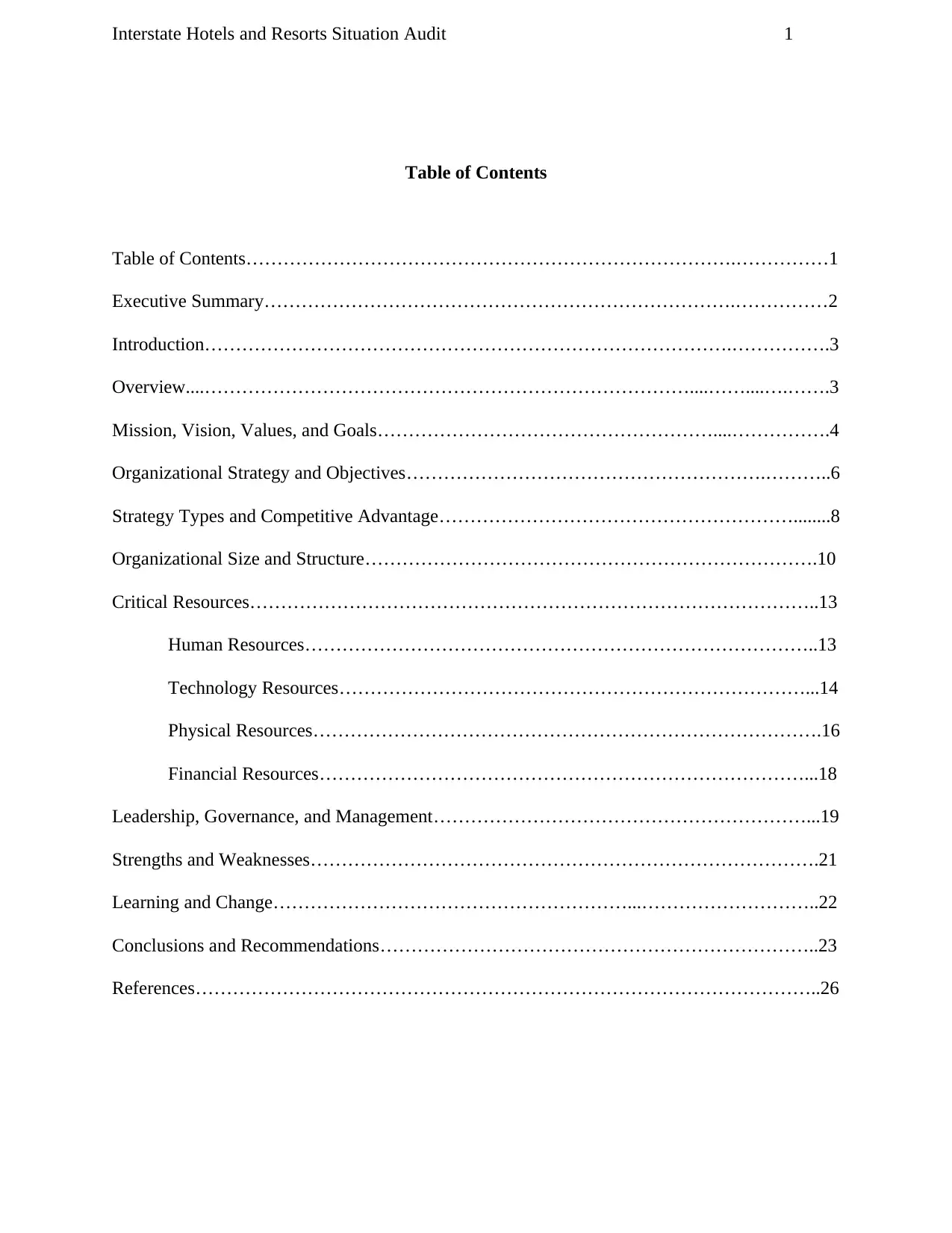
Interstate Hotels and Resorts Situation Audit 1
Table of Contents
Table of Contents…………………………………………………………………….……………1
Executive Summary………………………………………………………………….……………2
Introduction………………………………………………………………………….…………….3
Overview....……………………………………………………………………....……....….…….3
Mission, Vision, Values, and Goals………………………………………………....…………….4
Organizational Strategy and Objectives………………………………………………….………..6
Strategy Types and Competitive Advantage…………………………………………………........8
Organizational Size and Structure……………………………………………………………….10
Critical Resources………………………………………………………………………………..13
Human Resources………………………………………………………………………..13
Technology Resources…………………………………………………………………...14
Physical Resources……………………………………………………………………….16
Financial Resources……………………………………………………………………...18
Leadership, Governance, and Management……………………………………………………...19
Strengths and Weaknesses……………………………………………………………………….21
Learning and Change…………………………………………………...………………………..22
Conclusions and Recommendations……………………………………………………………..23
References………………………………………………………………………………………..26
Table of Contents
Table of Contents…………………………………………………………………….……………1
Executive Summary………………………………………………………………….……………2
Introduction………………………………………………………………………….…………….3
Overview....……………………………………………………………………....……....….…….3
Mission, Vision, Values, and Goals………………………………………………....…………….4
Organizational Strategy and Objectives………………………………………………….………..6
Strategy Types and Competitive Advantage…………………………………………………........8
Organizational Size and Structure……………………………………………………………….10
Critical Resources………………………………………………………………………………..13
Human Resources………………………………………………………………………..13
Technology Resources…………………………………………………………………...14
Physical Resources……………………………………………………………………….16
Financial Resources……………………………………………………………………...18
Leadership, Governance, and Management……………………………………………………...19
Strengths and Weaknesses……………………………………………………………………….21
Learning and Change…………………………………………………...………………………..22
Conclusions and Recommendations……………………………………………………………..23
References………………………………………………………………………………………..26
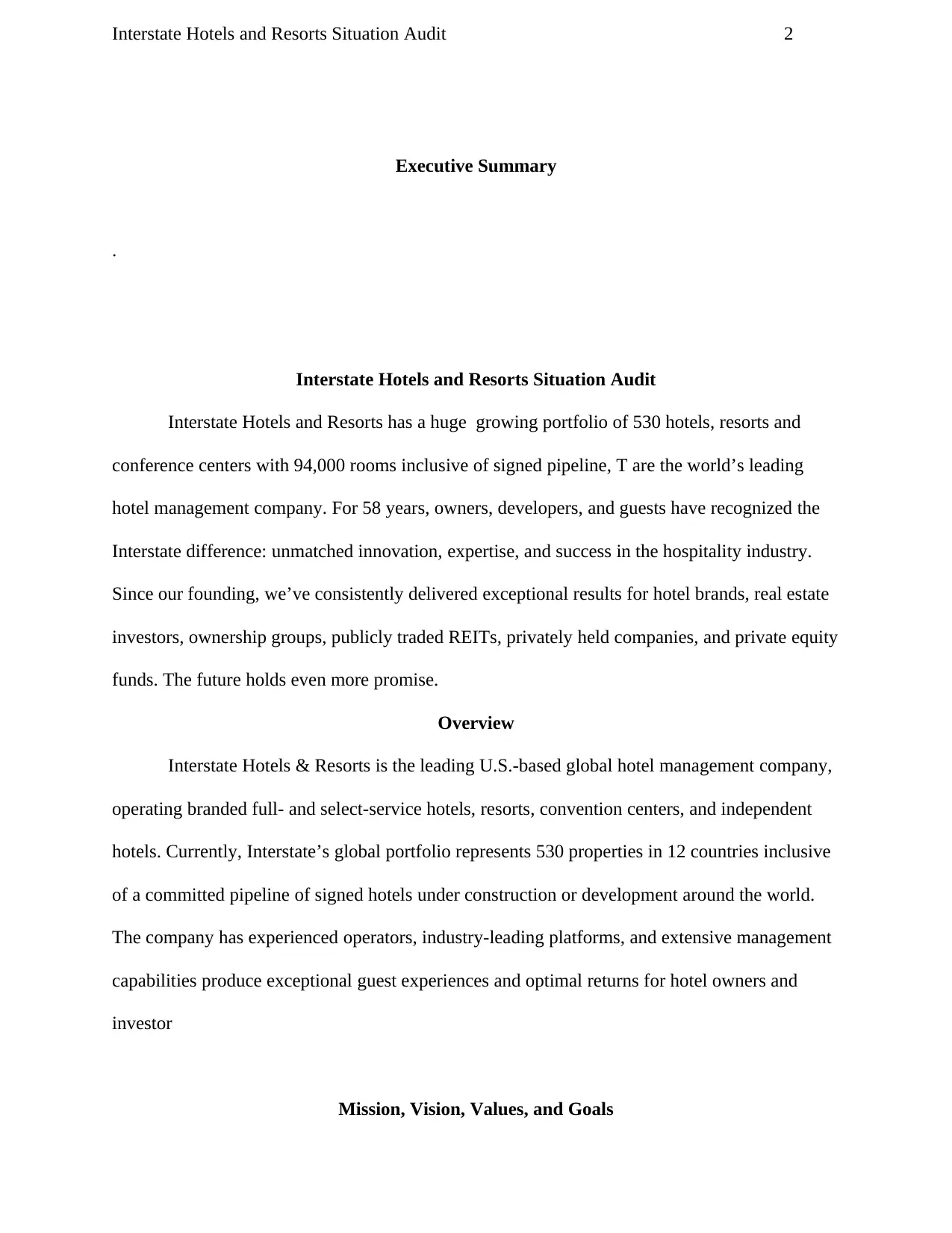
Interstate Hotels and Resorts Situation Audit 2
Executive Summary
.
Interstate Hotels and Resorts Situation Audit
Interstate Hotels and Resorts has a huge growing portfolio of 530 hotels, resorts and
conference centers with 94,000 rooms inclusive of signed pipeline, T are the world’s leading
hotel management company. For 58 years, owners, developers, and guests have recognized the
Interstate difference: unmatched innovation, expertise, and success in the hospitality industry.
Since our founding, we’ve consistently delivered exceptional results for hotel brands, real estate
investors, ownership groups, publicly traded REITs, privately held companies, and private equity
funds. The future holds even more promise.
Overview
Interstate Hotels & Resorts is the leading U.S.-based global hotel management company,
operating branded full- and select-service hotels, resorts, convention centers, and independent
hotels. Currently, Interstate’s global portfolio represents 530 properties in 12 countries inclusive
of a committed pipeline of signed hotels under construction or development around the world.
The company has experienced operators, industry-leading platforms, and extensive management
capabilities produce exceptional guest experiences and optimal returns for hotel owners and
investor
Mission, Vision, Values, and Goals
Executive Summary
.
Interstate Hotels and Resorts Situation Audit
Interstate Hotels and Resorts has a huge growing portfolio of 530 hotels, resorts and
conference centers with 94,000 rooms inclusive of signed pipeline, T are the world’s leading
hotel management company. For 58 years, owners, developers, and guests have recognized the
Interstate difference: unmatched innovation, expertise, and success in the hospitality industry.
Since our founding, we’ve consistently delivered exceptional results for hotel brands, real estate
investors, ownership groups, publicly traded REITs, privately held companies, and private equity
funds. The future holds even more promise.
Overview
Interstate Hotels & Resorts is the leading U.S.-based global hotel management company,
operating branded full- and select-service hotels, resorts, convention centers, and independent
hotels. Currently, Interstate’s global portfolio represents 530 properties in 12 countries inclusive
of a committed pipeline of signed hotels under construction or development around the world.
The company has experienced operators, industry-leading platforms, and extensive management
capabilities produce exceptional guest experiences and optimal returns for hotel owners and
investor
Mission, Vision, Values, and Goals
⊘ This is a preview!⊘
Do you want full access?
Subscribe today to unlock all pages.

Trusted by 1+ million students worldwide
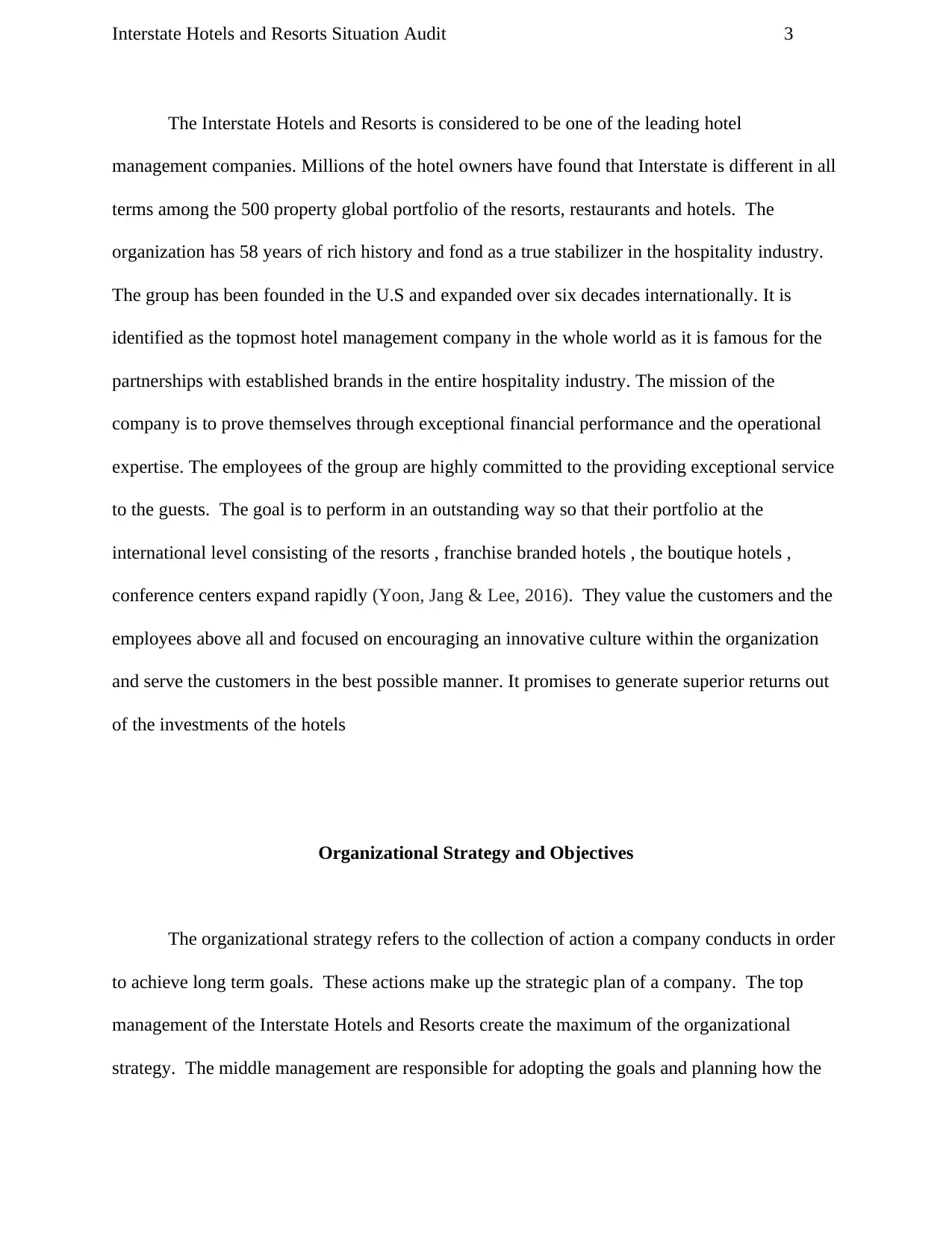
Interstate Hotels and Resorts Situation Audit 3
The Interstate Hotels and Resorts is considered to be one of the leading hotel
management companies. Millions of the hotel owners have found that Interstate is different in all
terms among the 500 property global portfolio of the resorts, restaurants and hotels. The
organization has 58 years of rich history and fond as a true stabilizer in the hospitality industry.
The group has been founded in the U.S and expanded over six decades internationally. It is
identified as the topmost hotel management company in the whole world as it is famous for the
partnerships with established brands in the entire hospitality industry. The mission of the
company is to prove themselves through exceptional financial performance and the operational
expertise. The employees of the group are highly committed to the providing exceptional service
to the guests. The goal is to perform in an outstanding way so that their portfolio at the
international level consisting of the resorts , franchise branded hotels , the boutique hotels ,
conference centers expand rapidly (Yoon, Jang & Lee, 2016). They value the customers and the
employees above all and focused on encouraging an innovative culture within the organization
and serve the customers in the best possible manner. It promises to generate superior returns out
of the investments of the hotels
Organizational Strategy and Objectives
The organizational strategy refers to the collection of action a company conducts in order
to achieve long term goals. These actions make up the strategic plan of a company. The top
management of the Interstate Hotels and Resorts create the maximum of the organizational
strategy. The middle management are responsible for adopting the goals and planning how the
The Interstate Hotels and Resorts is considered to be one of the leading hotel
management companies. Millions of the hotel owners have found that Interstate is different in all
terms among the 500 property global portfolio of the resorts, restaurants and hotels. The
organization has 58 years of rich history and fond as a true stabilizer in the hospitality industry.
The group has been founded in the U.S and expanded over six decades internationally. It is
identified as the topmost hotel management company in the whole world as it is famous for the
partnerships with established brands in the entire hospitality industry. The mission of the
company is to prove themselves through exceptional financial performance and the operational
expertise. The employees of the group are highly committed to the providing exceptional service
to the guests. The goal is to perform in an outstanding way so that their portfolio at the
international level consisting of the resorts , franchise branded hotels , the boutique hotels ,
conference centers expand rapidly (Yoon, Jang & Lee, 2016). They value the customers and the
employees above all and focused on encouraging an innovative culture within the organization
and serve the customers in the best possible manner. It promises to generate superior returns out
of the investments of the hotels
Organizational Strategy and Objectives
The organizational strategy refers to the collection of action a company conducts in order
to achieve long term goals. These actions make up the strategic plan of a company. The top
management of the Interstate Hotels and Resorts create the maximum of the organizational
strategy. The middle management are responsible for adopting the goals and planning how the
Paraphrase This Document
Need a fresh take? Get an instant paraphrase of this document with our AI Paraphraser
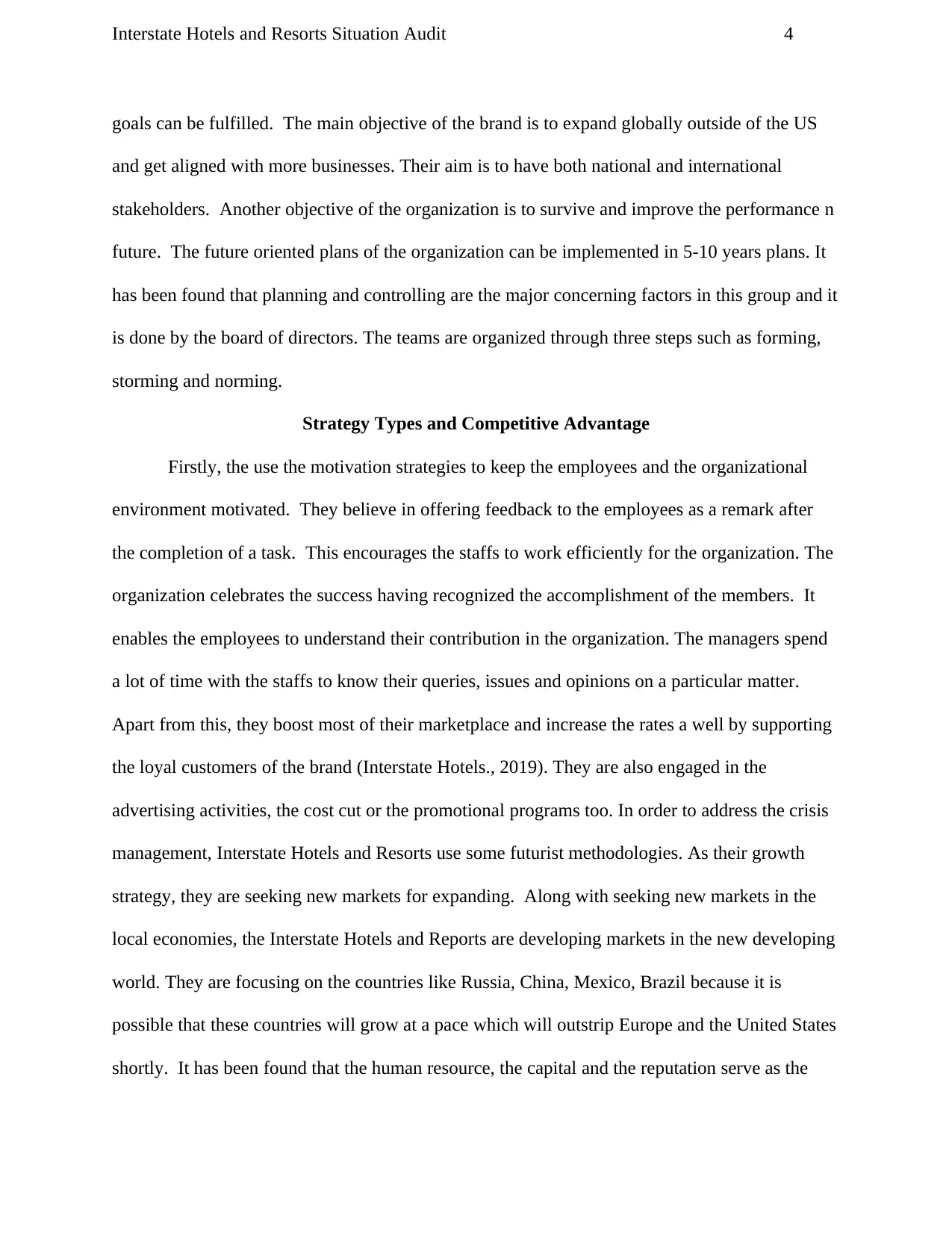
Interstate Hotels and Resorts Situation Audit 4
goals can be fulfilled. The main objective of the brand is to expand globally outside of the US
and get aligned with more businesses. Their aim is to have both national and international
stakeholders. Another objective of the organization is to survive and improve the performance n
future. The future oriented plans of the organization can be implemented in 5-10 years plans. It
has been found that planning and controlling are the major concerning factors in this group and it
is done by the board of directors. The teams are organized through three steps such as forming,
storming and norming.
Strategy Types and Competitive Advantage
Firstly, the use the motivation strategies to keep the employees and the organizational
environment motivated. They believe in offering feedback to the employees as a remark after
the completion of a task. This encourages the staffs to work efficiently for the organization. The
organization celebrates the success having recognized the accomplishment of the members. It
enables the employees to understand their contribution in the organization. The managers spend
a lot of time with the staffs to know their queries, issues and opinions on a particular matter.
Apart from this, they boost most of their marketplace and increase the rates a well by supporting
the loyal customers of the brand (Interstate Hotels., 2019). They are also engaged in the
advertising activities, the cost cut or the promotional programs too. In order to address the crisis
management, Interstate Hotels and Resorts use some futurist methodologies. As their growth
strategy, they are seeking new markets for expanding. Along with seeking new markets in the
local economies, the Interstate Hotels and Reports are developing markets in the new developing
world. They are focusing on the countries like Russia, China, Mexico, Brazil because it is
possible that these countries will grow at a pace which will outstrip Europe and the United States
shortly. It has been found that the human resource, the capital and the reputation serve as the
goals can be fulfilled. The main objective of the brand is to expand globally outside of the US
and get aligned with more businesses. Their aim is to have both national and international
stakeholders. Another objective of the organization is to survive and improve the performance n
future. The future oriented plans of the organization can be implemented in 5-10 years plans. It
has been found that planning and controlling are the major concerning factors in this group and it
is done by the board of directors. The teams are organized through three steps such as forming,
storming and norming.
Strategy Types and Competitive Advantage
Firstly, the use the motivation strategies to keep the employees and the organizational
environment motivated. They believe in offering feedback to the employees as a remark after
the completion of a task. This encourages the staffs to work efficiently for the organization. The
organization celebrates the success having recognized the accomplishment of the members. It
enables the employees to understand their contribution in the organization. The managers spend
a lot of time with the staffs to know their queries, issues and opinions on a particular matter.
Apart from this, they boost most of their marketplace and increase the rates a well by supporting
the loyal customers of the brand (Interstate Hotels., 2019). They are also engaged in the
advertising activities, the cost cut or the promotional programs too. In order to address the crisis
management, Interstate Hotels and Resorts use some futurist methodologies. As their growth
strategy, they are seeking new markets for expanding. Along with seeking new markets in the
local economies, the Interstate Hotels and Reports are developing markets in the new developing
world. They are focusing on the countries like Russia, China, Mexico, Brazil because it is
possible that these countries will grow at a pace which will outstrip Europe and the United States
shortly. It has been found that the human resource, the capital and the reputation serve as the
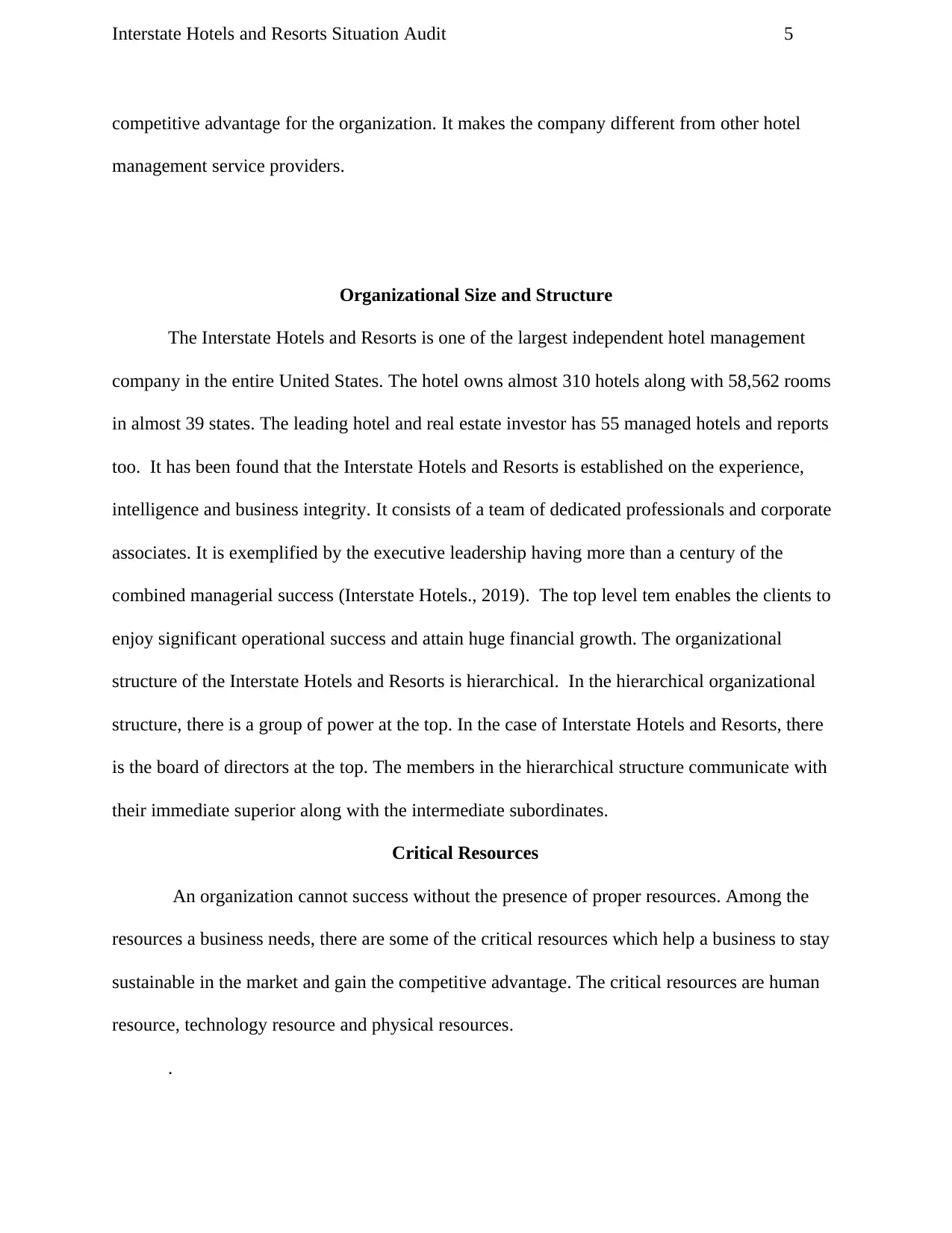
Interstate Hotels and Resorts Situation Audit 5
competitive advantage for the organization. It makes the company different from other hotel
management service providers.
Organizational Size and Structure
The Interstate Hotels and Resorts is one of the largest independent hotel management
company in the entire United States. The hotel owns almost 310 hotels along with 58,562 rooms
in almost 39 states. The leading hotel and real estate investor has 55 managed hotels and reports
too. It has been found that the Interstate Hotels and Resorts is established on the experience,
intelligence and business integrity. It consists of a team of dedicated professionals and corporate
associates. It is exemplified by the executive leadership having more than a century of the
combined managerial success (Interstate Hotels., 2019). The top level tem enables the clients to
enjoy significant operational success and attain huge financial growth. The organizational
structure of the Interstate Hotels and Resorts is hierarchical. In the hierarchical organizational
structure, there is a group of power at the top. In the case of Interstate Hotels and Resorts, there
is the board of directors at the top. The members in the hierarchical structure communicate with
their immediate superior along with the intermediate subordinates.
Critical Resources
An organization cannot success without the presence of proper resources. Among the
resources a business needs, there are some of the critical resources which help a business to stay
sustainable in the market and gain the competitive advantage. The critical resources are human
resource, technology resource and physical resources.
.
competitive advantage for the organization. It makes the company different from other hotel
management service providers.
Organizational Size and Structure
The Interstate Hotels and Resorts is one of the largest independent hotel management
company in the entire United States. The hotel owns almost 310 hotels along with 58,562 rooms
in almost 39 states. The leading hotel and real estate investor has 55 managed hotels and reports
too. It has been found that the Interstate Hotels and Resorts is established on the experience,
intelligence and business integrity. It consists of a team of dedicated professionals and corporate
associates. It is exemplified by the executive leadership having more than a century of the
combined managerial success (Interstate Hotels., 2019). The top level tem enables the clients to
enjoy significant operational success and attain huge financial growth. The organizational
structure of the Interstate Hotels and Resorts is hierarchical. In the hierarchical organizational
structure, there is a group of power at the top. In the case of Interstate Hotels and Resorts, there
is the board of directors at the top. The members in the hierarchical structure communicate with
their immediate superior along with the intermediate subordinates.
Critical Resources
An organization cannot success without the presence of proper resources. Among the
resources a business needs, there are some of the critical resources which help a business to stay
sustainable in the market and gain the competitive advantage. The critical resources are human
resource, technology resource and physical resources.
.
⊘ This is a preview!⊘
Do you want full access?
Subscribe today to unlock all pages.

Trusted by 1+ million students worldwide
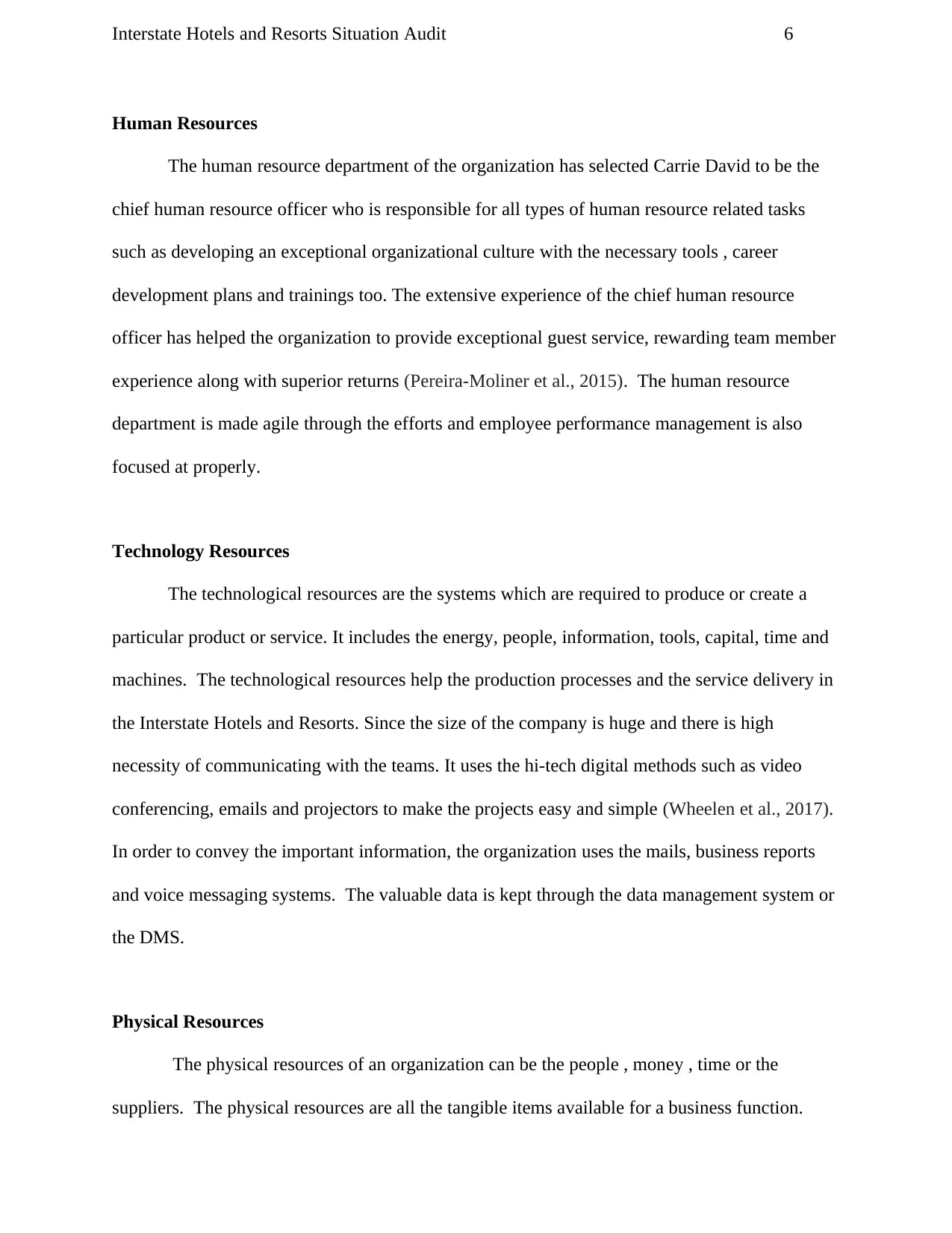
Interstate Hotels and Resorts Situation Audit 6
Human Resources
The human resource department of the organization has selected Carrie David to be the
chief human resource officer who is responsible for all types of human resource related tasks
such as developing an exceptional organizational culture with the necessary tools , career
development plans and trainings too. The extensive experience of the chief human resource
officer has helped the organization to provide exceptional guest service, rewarding team member
experience along with superior returns (Pereira-Moliner et al., 2015). The human resource
department is made agile through the efforts and employee performance management is also
focused at properly.
Technology Resources
The technological resources are the systems which are required to produce or create a
particular product or service. It includes the energy, people, information, tools, capital, time and
machines. The technological resources help the production processes and the service delivery in
the Interstate Hotels and Resorts. Since the size of the company is huge and there is high
necessity of communicating with the teams. It uses the hi-tech digital methods such as video
conferencing, emails and projectors to make the projects easy and simple (Wheelen et al., 2017).
In order to convey the important information, the organization uses the mails, business reports
and voice messaging systems. The valuable data is kept through the data management system or
the DMS.
Physical Resources
The physical resources of an organization can be the people , money , time or the
suppliers. The physical resources are all the tangible items available for a business function.
Human Resources
The human resource department of the organization has selected Carrie David to be the
chief human resource officer who is responsible for all types of human resource related tasks
such as developing an exceptional organizational culture with the necessary tools , career
development plans and trainings too. The extensive experience of the chief human resource
officer has helped the organization to provide exceptional guest service, rewarding team member
experience along with superior returns (Pereira-Moliner et al., 2015). The human resource
department is made agile through the efforts and employee performance management is also
focused at properly.
Technology Resources
The technological resources are the systems which are required to produce or create a
particular product or service. It includes the energy, people, information, tools, capital, time and
machines. The technological resources help the production processes and the service delivery in
the Interstate Hotels and Resorts. Since the size of the company is huge and there is high
necessity of communicating with the teams. It uses the hi-tech digital methods such as video
conferencing, emails and projectors to make the projects easy and simple (Wheelen et al., 2017).
In order to convey the important information, the organization uses the mails, business reports
and voice messaging systems. The valuable data is kept through the data management system or
the DMS.
Physical Resources
The physical resources of an organization can be the people , money , time or the
suppliers. The physical resources are all the tangible items available for a business function.
Paraphrase This Document
Need a fresh take? Get an instant paraphrase of this document with our AI Paraphraser
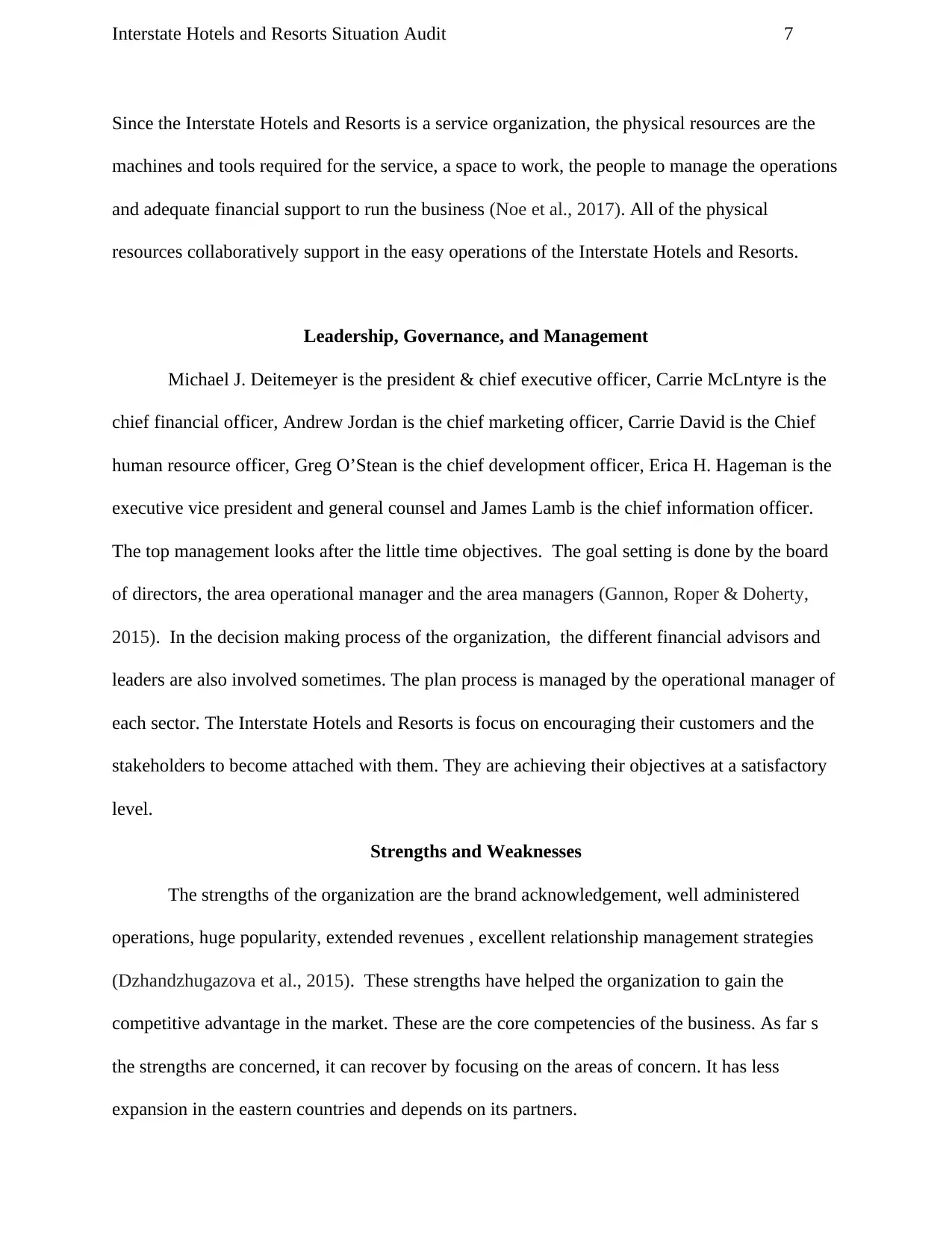
Interstate Hotels and Resorts Situation Audit 7
Since the Interstate Hotels and Resorts is a service organization, the physical resources are the
machines and tools required for the service, a space to work, the people to manage the operations
and adequate financial support to run the business (Noe et al., 2017). All of the physical
resources collaboratively support in the easy operations of the Interstate Hotels and Resorts.
Leadership, Governance, and Management
Michael J. Deitemeyer is the president & chief executive officer, Carrie McLntyre is the
chief financial officer, Andrew Jordan is the chief marketing officer, Carrie David is the Chief
human resource officer, Greg O’Stean is the chief development officer, Erica H. Hageman is the
executive vice president and general counsel and James Lamb is the chief information officer.
The top management looks after the little time objectives. The goal setting is done by the board
of directors, the area operational manager and the area managers (Gannon, Roper & Doherty,
2015). In the decision making process of the organization, the different financial advisors and
leaders are also involved sometimes. The plan process is managed by the operational manager of
each sector. The Interstate Hotels and Resorts is focus on encouraging their customers and the
stakeholders to become attached with them. They are achieving their objectives at a satisfactory
level.
Strengths and Weaknesses
The strengths of the organization are the brand acknowledgement, well administered
operations, huge popularity, extended revenues , excellent relationship management strategies
(Dzhandzhugazova et al., 2015). These strengths have helped the organization to gain the
competitive advantage in the market. These are the core competencies of the business. As far s
the strengths are concerned, it can recover by focusing on the areas of concern. It has less
expansion in the eastern countries and depends on its partners.
Since the Interstate Hotels and Resorts is a service organization, the physical resources are the
machines and tools required for the service, a space to work, the people to manage the operations
and adequate financial support to run the business (Noe et al., 2017). All of the physical
resources collaboratively support in the easy operations of the Interstate Hotels and Resorts.
Leadership, Governance, and Management
Michael J. Deitemeyer is the president & chief executive officer, Carrie McLntyre is the
chief financial officer, Andrew Jordan is the chief marketing officer, Carrie David is the Chief
human resource officer, Greg O’Stean is the chief development officer, Erica H. Hageman is the
executive vice president and general counsel and James Lamb is the chief information officer.
The top management looks after the little time objectives. The goal setting is done by the board
of directors, the area operational manager and the area managers (Gannon, Roper & Doherty,
2015). In the decision making process of the organization, the different financial advisors and
leaders are also involved sometimes. The plan process is managed by the operational manager of
each sector. The Interstate Hotels and Resorts is focus on encouraging their customers and the
stakeholders to become attached with them. They are achieving their objectives at a satisfactory
level.
Strengths and Weaknesses
The strengths of the organization are the brand acknowledgement, well administered
operations, huge popularity, extended revenues , excellent relationship management strategies
(Dzhandzhugazova et al., 2015). These strengths have helped the organization to gain the
competitive advantage in the market. These are the core competencies of the business. As far s
the strengths are concerned, it can recover by focusing on the areas of concern. It has less
expansion in the eastern countries and depends on its partners.
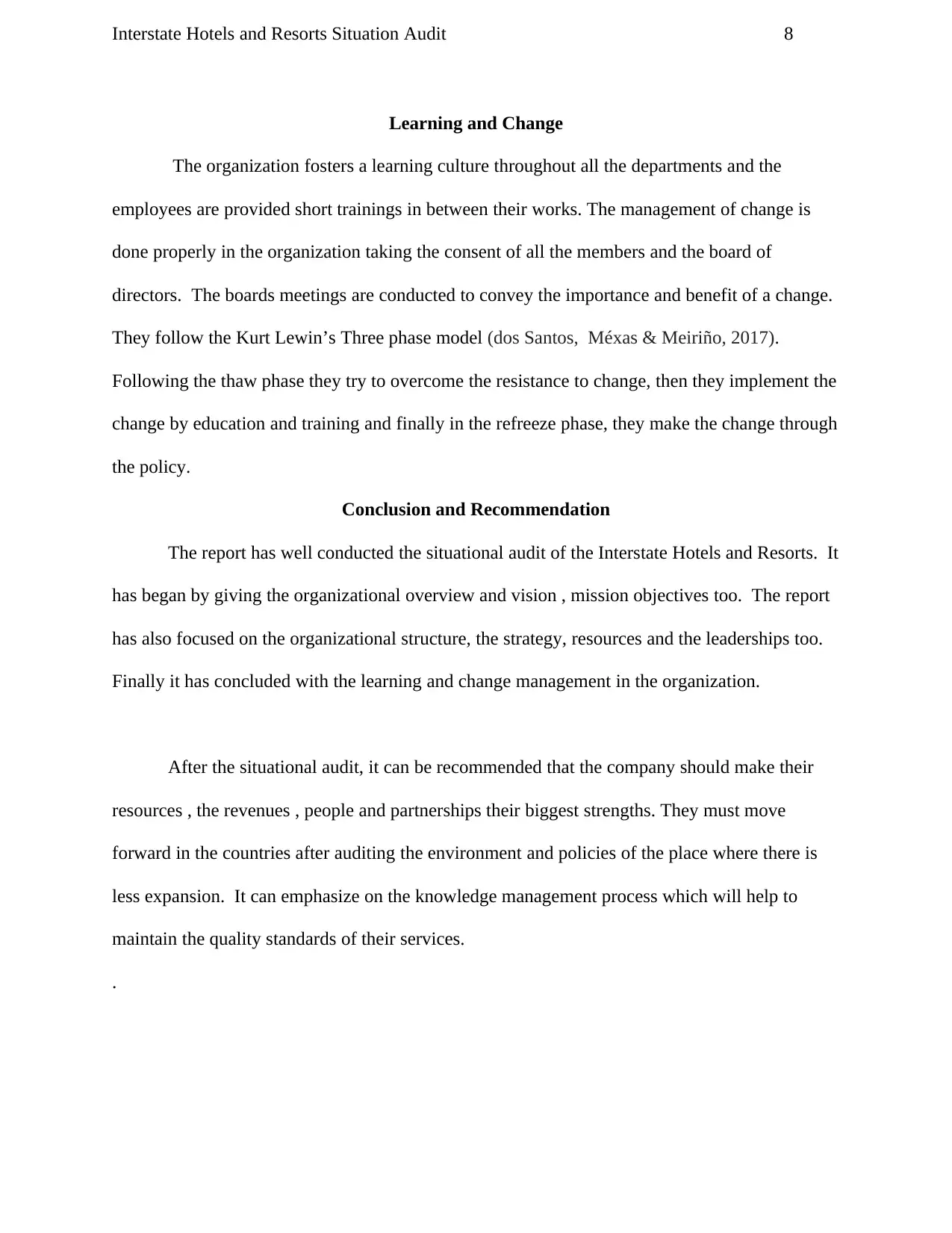
Interstate Hotels and Resorts Situation Audit 8
Learning and Change
The organization fosters a learning culture throughout all the departments and the
employees are provided short trainings in between their works. The management of change is
done properly in the organization taking the consent of all the members and the board of
directors. The boards meetings are conducted to convey the importance and benefit of a change.
They follow the Kurt Lewin’s Three phase model (dos Santos, Méxas & Meiriño, 2017).
Following the thaw phase they try to overcome the resistance to change, then they implement the
change by education and training and finally in the refreeze phase, they make the change through
the policy.
Conclusion and Recommendation
The report has well conducted the situational audit of the Interstate Hotels and Resorts. It
has began by giving the organizational overview and vision , mission objectives too. The report
has also focused on the organizational structure, the strategy, resources and the leaderships too.
Finally it has concluded with the learning and change management in the organization.
After the situational audit, it can be recommended that the company should make their
resources , the revenues , people and partnerships their biggest strengths. They must move
forward in the countries after auditing the environment and policies of the place where there is
less expansion. It can emphasize on the knowledge management process which will help to
maintain the quality standards of their services.
.
Learning and Change
The organization fosters a learning culture throughout all the departments and the
employees are provided short trainings in between their works. The management of change is
done properly in the organization taking the consent of all the members and the board of
directors. The boards meetings are conducted to convey the importance and benefit of a change.
They follow the Kurt Lewin’s Three phase model (dos Santos, Méxas & Meiriño, 2017).
Following the thaw phase they try to overcome the resistance to change, then they implement the
change by education and training and finally in the refreeze phase, they make the change through
the policy.
Conclusion and Recommendation
The report has well conducted the situational audit of the Interstate Hotels and Resorts. It
has began by giving the organizational overview and vision , mission objectives too. The report
has also focused on the organizational structure, the strategy, resources and the leaderships too.
Finally it has concluded with the learning and change management in the organization.
After the situational audit, it can be recommended that the company should make their
resources , the revenues , people and partnerships their biggest strengths. They must move
forward in the countries after auditing the environment and policies of the place where there is
less expansion. It can emphasize on the knowledge management process which will help to
maintain the quality standards of their services.
.
⊘ This is a preview!⊘
Do you want full access?
Subscribe today to unlock all pages.

Trusted by 1+ million students worldwide
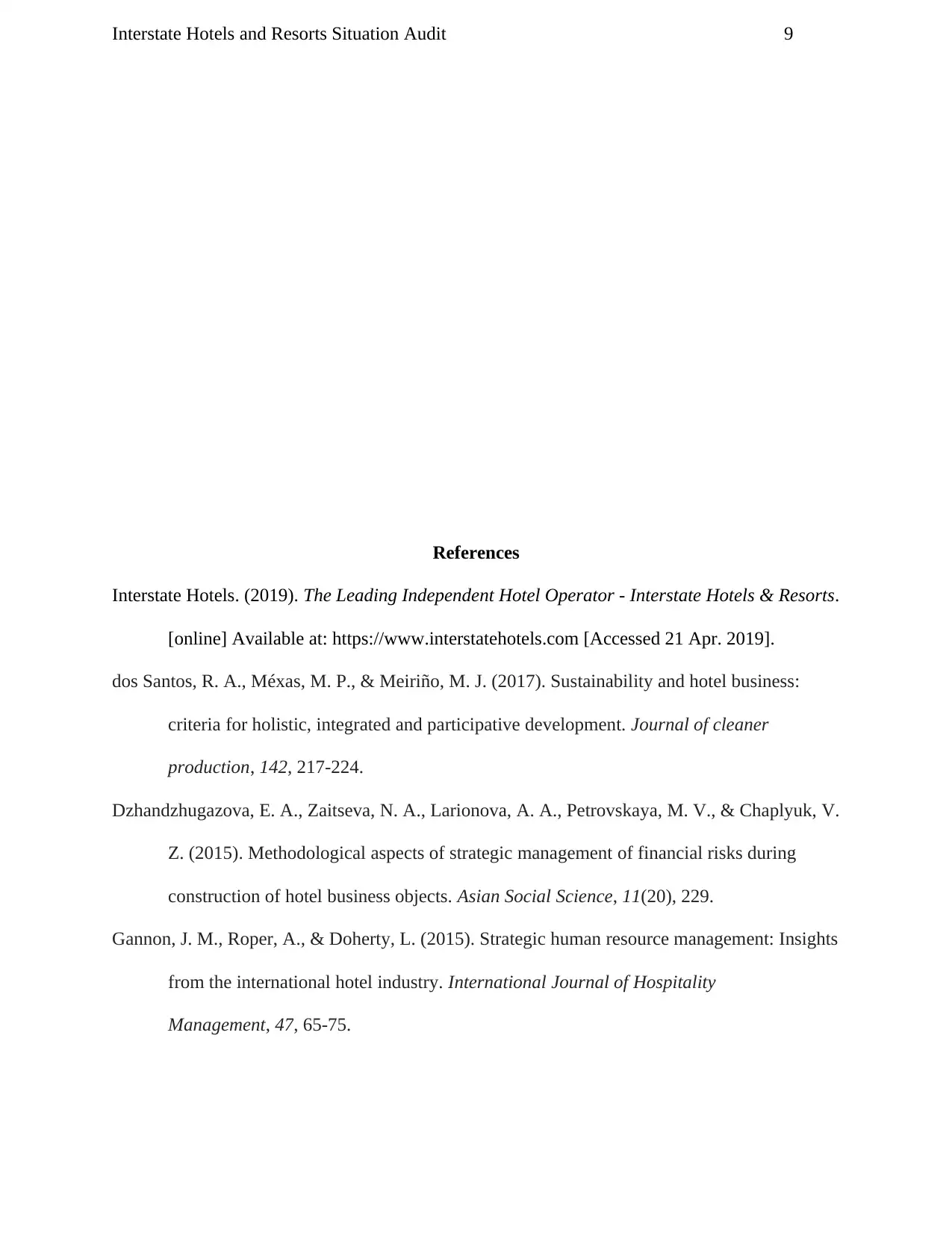
Interstate Hotels and Resorts Situation Audit 9
References
Interstate Hotels. (2019). The Leading Independent Hotel Operator - Interstate Hotels & Resorts.
[online] Available at: https://www.interstatehotels.com [Accessed 21 Apr. 2019].
dos Santos, R. A., Méxas, M. P., & Meiriño, M. J. (2017). Sustainability and hotel business:
criteria for holistic, integrated and participative development. Journal of cleaner
production, 142, 217-224.
Dzhandzhugazova, E. A., Zaitseva, N. A., Larionova, A. A., Petrovskaya, M. V., & Chaplyuk, V.
Z. (2015). Methodological aspects of strategic management of financial risks during
construction of hotel business objects. Asian Social Science, 11(20), 229.
Gannon, J. M., Roper, A., & Doherty, L. (2015). Strategic human resource management: Insights
from the international hotel industry. International Journal of Hospitality
Management, 47, 65-75.
References
Interstate Hotels. (2019). The Leading Independent Hotel Operator - Interstate Hotels & Resorts.
[online] Available at: https://www.interstatehotels.com [Accessed 21 Apr. 2019].
dos Santos, R. A., Méxas, M. P., & Meiriño, M. J. (2017). Sustainability and hotel business:
criteria for holistic, integrated and participative development. Journal of cleaner
production, 142, 217-224.
Dzhandzhugazova, E. A., Zaitseva, N. A., Larionova, A. A., Petrovskaya, M. V., & Chaplyuk, V.
Z. (2015). Methodological aspects of strategic management of financial risks during
construction of hotel business objects. Asian Social Science, 11(20), 229.
Gannon, J. M., Roper, A., & Doherty, L. (2015). Strategic human resource management: Insights
from the international hotel industry. International Journal of Hospitality
Management, 47, 65-75.
Paraphrase This Document
Need a fresh take? Get an instant paraphrase of this document with our AI Paraphraser
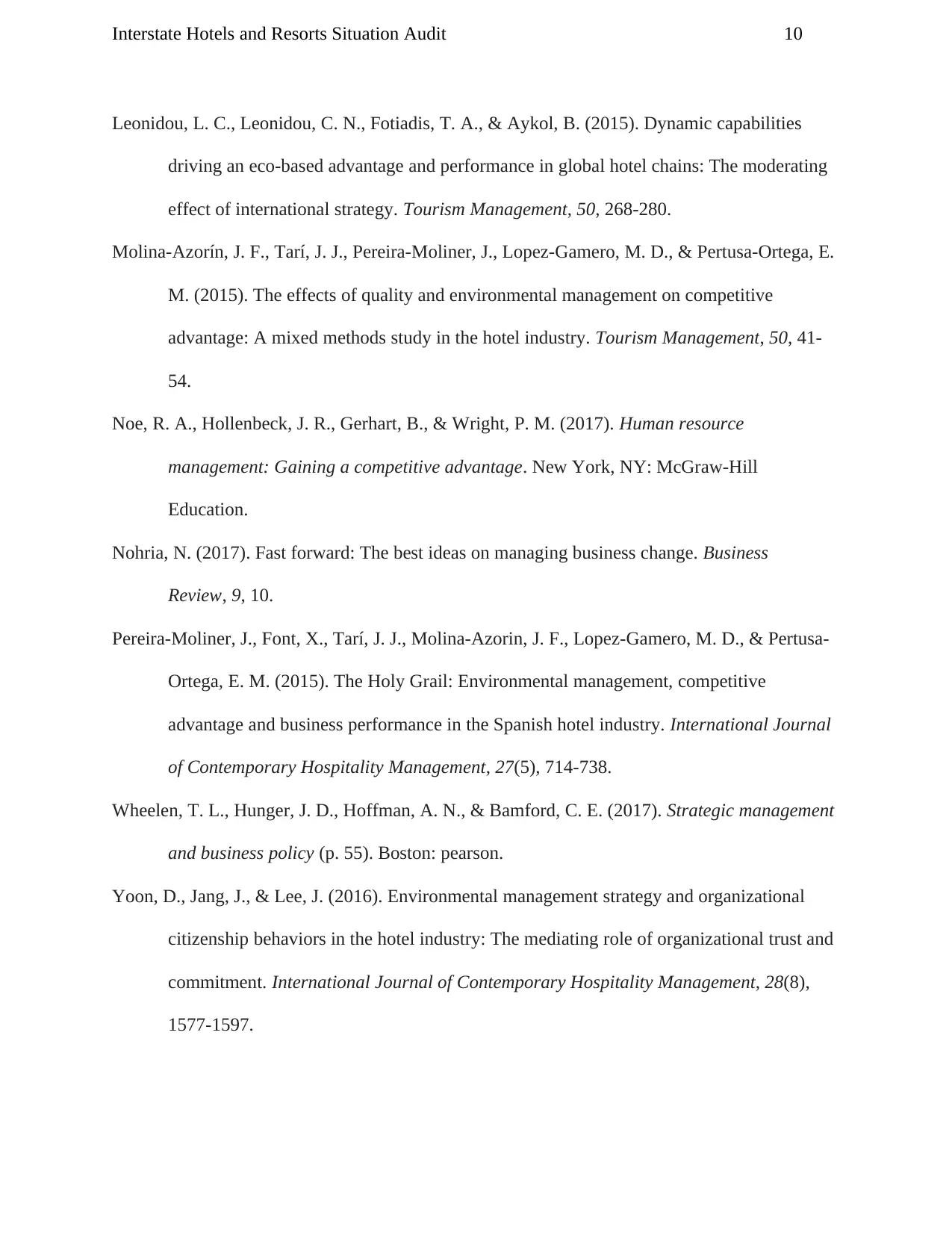
Interstate Hotels and Resorts Situation Audit 10
Leonidou, L. C., Leonidou, C. N., Fotiadis, T. A., & Aykol, B. (2015). Dynamic capabilities
driving an eco-based advantage and performance in global hotel chains: The moderating
effect of international strategy. Tourism Management, 50, 268-280.
Molina-Azorín, J. F., Tarí, J. J., Pereira-Moliner, J., Lopez-Gamero, M. D., & Pertusa-Ortega, E.
M. (2015). The effects of quality and environmental management on competitive
advantage: A mixed methods study in the hotel industry. Tourism Management, 50, 41-
54.
Noe, R. A., Hollenbeck, J. R., Gerhart, B., & Wright, P. M. (2017). Human resource
management: Gaining a competitive advantage. New York, NY: McGraw-Hill
Education.
Nohria, N. (2017). Fast forward: The best ideas on managing business change. Business
Review, 9, 10.
Pereira-Moliner, J., Font, X., Tarí, J. J., Molina-Azorin, J. F., Lopez-Gamero, M. D., & Pertusa-
Ortega, E. M. (2015). The Holy Grail: Environmental management, competitive
advantage and business performance in the Spanish hotel industry. International Journal
of Contemporary Hospitality Management, 27(5), 714-738.
Wheelen, T. L., Hunger, J. D., Hoffman, A. N., & Bamford, C. E. (2017). Strategic management
and business policy (p. 55). Boston: pearson.
Yoon, D., Jang, J., & Lee, J. (2016). Environmental management strategy and organizational
citizenship behaviors in the hotel industry: The mediating role of organizational trust and
commitment. International Journal of Contemporary Hospitality Management, 28(8),
1577-1597.
Leonidou, L. C., Leonidou, C. N., Fotiadis, T. A., & Aykol, B. (2015). Dynamic capabilities
driving an eco-based advantage and performance in global hotel chains: The moderating
effect of international strategy. Tourism Management, 50, 268-280.
Molina-Azorín, J. F., Tarí, J. J., Pereira-Moliner, J., Lopez-Gamero, M. D., & Pertusa-Ortega, E.
M. (2015). The effects of quality and environmental management on competitive
advantage: A mixed methods study in the hotel industry. Tourism Management, 50, 41-
54.
Noe, R. A., Hollenbeck, J. R., Gerhart, B., & Wright, P. M. (2017). Human resource
management: Gaining a competitive advantage. New York, NY: McGraw-Hill
Education.
Nohria, N. (2017). Fast forward: The best ideas on managing business change. Business
Review, 9, 10.
Pereira-Moliner, J., Font, X., Tarí, J. J., Molina-Azorin, J. F., Lopez-Gamero, M. D., & Pertusa-
Ortega, E. M. (2015). The Holy Grail: Environmental management, competitive
advantage and business performance in the Spanish hotel industry. International Journal
of Contemporary Hospitality Management, 27(5), 714-738.
Wheelen, T. L., Hunger, J. D., Hoffman, A. N., & Bamford, C. E. (2017). Strategic management
and business policy (p. 55). Boston: pearson.
Yoon, D., Jang, J., & Lee, J. (2016). Environmental management strategy and organizational
citizenship behaviors in the hotel industry: The mediating role of organizational trust and
commitment. International Journal of Contemporary Hospitality Management, 28(8),
1577-1597.
1 out of 11
Related Documents
Your All-in-One AI-Powered Toolkit for Academic Success.
+13062052269
info@desklib.com
Available 24*7 on WhatsApp / Email
![[object Object]](/_next/static/media/star-bottom.7253800d.svg)
Unlock your academic potential
Copyright © 2020–2025 A2Z Services. All Rights Reserved. Developed and managed by ZUCOL.



